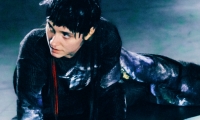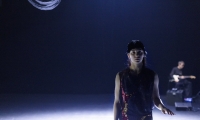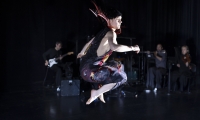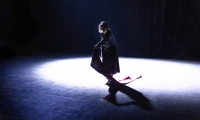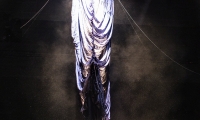Direction and concept
Kris Verdonck
Music composition
Annelies Van Parys
Text & Libretto
Kris Verdonck
Ictus line-up
Aurélie Entringer, viola
Gerrit Nulens, percussion
Tom Pauwels, guitar
Michael Schmid, flutes
Performers
Actress: Katelijne Damen
Singer: Anna Clare Hauf
Dancer: Mooni Van Tichel
Scenography:Kris Verdonck in collaboration with Karolien Nuyttens
Lightdesign: Luc Schaltin
Dramaturgy: Kristof van Baarle
Costumes: Sofie Durnez in collaboration with Karolien Nuyttens
Technics: Daniel Romero Calderon, Vincent Malstaf, Pim Mannaerts
Coordination: Britt Roger Sas
PRODUCTION
Production: A Two Dogs Company / Muziektheater Transparant
Coproduction: Klarafestival, Theater Rotterdam (for ACT: Art, Climate & Transition - Creative Europe project) en Perpodium
In collaboration with: Théâtre Varia & Kaaitheater
With the support of: Tax Shelter of the Belgian Government via Cronos Invest, Flemish Community, Flemish Community Commission
All pictures: Nika Prokopenka / Muziektheater Transparant
We are food
Val Plumwood
A new humility
PREY is a new music theater production by Kris Verdonck / A Two Dogs Company and Muziektheater Transparant, with original music by Annelies Van Parys, in co-production with Klara festival and in collaboration with Ictus ensemble.
How can we change the way we view humankind from a radical ecological perspective? What stories help us better understand the disruptions caused by the climate crisis? These are the questions that lie at the heart of PREY.
The starting point of this inquiry is the life and work of Australian ecofeminist Val Plumwood (1938-2008). After an attack by a crocodile, which she miraculously survived, she was one of the first to call for a new humility by placing humans back into the food chain of hunter and prey. Death occupies a central place in this idea. The texts she wrote about this are beautiful yet confronting and appeal to the imagination.
PREY will consist of three solos by three generations of women. Each has its own focus: text/language, song/music and dance/performance. With each solo, the tension between the human and the landscape, performer and scenography, becomes more intense and intimate. The essence of PREY is finding consolation in the frightening fact that we too are food, that we too belong to an ecological cycle of life and death.
Kris Verdonck has gathered an extraordinary group of people around him for this performance: composer Annelies Van Parys, the ICTUS Ensemble, actress Katelijne Damen, singer Anna Clare Hauf and dancer Mooni Van Tichel. Verdonck is responsible for the scenography, a multimedia landscape in which the performers increasingly disappear and are swallowed up.
The premiere is scheduled for March 2023 at the Kaaitheater as part of the Klara Festival in Brussels.
Val Plumwood
In 1985, while on a canoe trip in Kakadu National Park, in northern Australia, Val Plumwood was attacked by a crocodile. It bit and dragged her underwater, up to three times. Plumwood survived this deadly attack, and the event would fundamentally change her view on life, death, and human beings. She had already been a key figure in the development of a radical eco-philosophy since the 1970s, and with the crocodile attack came a focus on the fragility of human beings and a desire for humility and connection. Plumwood was a pioneering eco-thinker, an important and yet often unheard reference for contemporary writers like Donna Haraway.
PREY starts from this unimaginable crocodile story and builds on two core ideas from Plumwood's oeuvre. First, there is the statement that “we are food”. Her encounter with the crocodile was a clear reminder that humans are a species that is also part of the food chain. Moreover, it is the dynamic of eating and being eaten that can reconnect us Westerners to our environment. As a result, death takes on a key function in the way living beings relate to each other and to the environment of which they are a part. Ecology, for her, is one big feast and being alive means being prey: a powerful antidote to fantasies of immortality and exclusivity.
For Plumwood, the idea of an immortal human being who is free to kill and exploit his environment was a consequence of a Western, rational, masculine worldview. This separated body and mind, nature and culture. Her feminism consisted mainly of a search for other narratives to connect people with their environment, and a plea for embodied experience. To be prey, after all, also means to be “body”, to be “flesh”. This is the second idea that PREY is inspired by: the bankruptcy of the classical Western narrative as a meaningful way to relate to the world. Plumwood found alternatives in the stories of Aboriginal people, but at the same time she did not deny that as a white intellectual she was always just a visitor in their world.
In PREY we see a friction between figures who cannot help but consider themselves to be at the center, and an environment that drives them away from that center. This is the paradox of the geological age of the Anthropocene, and perhaps this is where the performance finds its tragedy. The characters on stage have gone down the rabbit hole like some kind of 'Alice in wonderland', similar to Plumwood's life-and-death struggle with the crocodile, and there they have caught a glimpse of a different vision. Ever since, they keep looking for other ways to access that other universe, for ways to be prey and thus be connected to their environment. PREY is an attempt to give form to a traumatic event in which consolation and horror converge. Standing face to face with a crocodile must be a moment where your worldview is thoroughly shaken in a flash. It is also a moment that is difficult to repeat, which makes it necessary to look for other pathways. Or is such violence necessary?
Noh Theatre
Following Plumwood's plea for an alternative to the classical narrative, PREY draws on the Japanese traditional Noh theater. In Noh, the main character is usually the ghost of someone - or something - who died a traumatic death. These ghost stories are always intertwined with the landscapes in which they take place. It is as if the landscapes “contain” these stories, evoke them.
A Noh piece usually has three parts. The story does not proceed in a linear fashion but is repeated three times. First it is told with more distance, then it is retold from the perspective of a witness, and finally it is brought again, but as in a dream. Each repetition is more intimate, more intense and the structure leads to a surreal finale, as in a hallucination: a possible entrance into another reality.
Three solos – three generations
PREY, like a Noh piece, also consists of three movements. Each part is conceived as a solo for an actress, singer and dancer, respectively. Three generations of women take the stage, thus also telling something about how ecology is also about passing on from generation to generation. The first solo focuses on text and narrative and is played by Katelijne Damen, an actress with a long career in which she developed a precise and intriguing way of bringing a story. In the second solo, singer Anna Clare Hauf combines a low operatic voice with a rawer tone in a hard clash between harmony and more industrial vocals. Dancer and choreographer Mooni Van Tichel just graduated from P.A.R.T.S. and she will co-create and perform the third solo: a translation in dance of the fragility and violence in Plumwood's work.
Kris Verdonck will design the scenography for these solos. He will continue his trajectory of impressive stage settings with machines, projections and performative objects, as he also created for END, Conversations (at the end of the world) and Something (out of nothing). For PREY, Verdonck will be making a multimedia landscape of trees composed of drapes and projections. In this forest, the performers disappear into nothingness. Throughout the performance, this landscape transforms and zooms in on the enlarged base of a single tree. Gradually the performers are absorbed into their surroundings: a movement from a small person in a giant environment, to an interwovenness with a larger whole.
Annelies Van Parys will write a new composition for PREY for the renowned ICTUS Ensemble. Noh's three-part model, in which a different perspective is taken on the same theme three times, is gefundenes Fressen for her spectral music. The sound can be approached three times in completely different ways. The result will be a game of recognition and alienation in relation to the Eastern canon. Such a dialogue with a specific canon is characteristic of Van Parys' oeuvre, but for this project she really wants to immerse herself in the genre. She will compose for an unusual line-up: electric guitar (Tom Pauwels), flute (Michael Schmid), percussion (Gerrit Nulens) and viola (Aurélie Entringer).
Kris Verdonck and Kristof van Baarle will assemble the text, starting from Plumwood's oeuvre. It is not the intention to write a biography, but to find a theatrical form for her stories.
Consolation
With PREY, Kris Verdonck continues his body of work concerning a world in which humans are disappearing into the background. As the ecology debate these days demonstrates, this does not happen without a struggle. Denial or solutions that make use of even more technology - the same ones that got us into these problems in the first place - do not promise much good. But even for the growing group of people who do want to change something, the process of repositioning oneself is accompanied by existential questions, farewells and mourning. “Consolation might very well be what we need, for a world in which the end, for better or for worse, may become the new center. We will go onwards in a different mode of humanity, or not at all” (Val Plumwood - The Eye of the Crocodile).
All pictures: Nika Prokopenka / Muziektheater Transparant
Valt er te leven met het weerzinwekkende feit dat we voedsel zijn en deel uitmaken van een ecologische cyclus van leven en dood? Zet je schrap en daal af in een landschap waarin de mens niet langer de hoofdrol speelt.
“Wij zijn voedsel.”– The eye of the crocodile door Val Plumwood
Hoe kunnen we ons mens-zijn herdefiniëren vanuit een radicaal ecologisch perspectief? Welke narratieven helpen ons in de omgang met de ontwrichtende manifestaties van de klimaatcrisis? Deze vragen vormen het uitgangspunt van PREY, dat bestaat uit drie solo's van drie generaties vrouwen. Elke solo biedt via een ander medium (tekst/gesproken woord, zang/muziek of dans/performance) een eigen perspectief op hetzelfde thema. Zet je schrap en daal af in een scenografie waarin de mens niet langer de hoofdrol speelt. Kunnen we leven met het weerzinwekkende feit dat we voedsel zijn en deel uitmaken van een ecologische cyclus van leven en dood?
Uitgangspunt voor dit onderzoek vormt de Australische ecofeministe Val Plumwood (1936-2008). Nadat ze, tijdens een kanotocht, een dodelijke aanval van een zoutwaterkrokodil overleefde, was ze een van de eersten die een nieuwe nederigheid van de mens bepleitte. Ze opperde dat de mens opnieuw in de voedselketen moest worden opgenomen en dat de dood terug centraal moest worden gesteld. Met haar baanbrekend werk vormt Plumwood een belangrijke maar vaak vergeten referentie voor hedendaagse schrijvers als Donna Haraway.
De performance PREY neemt haar verhaal als uitgangspunt en geeft de spanning weer tussen individuen die zichzelf steeds weer als middelpunt zien en een omgeving die hen almaar verder van die centrale positie wegduwt.
Kris Verdonck verkent als regisseur de raakvlakken van beeldende kunst, theater, performance en architectuur. Meer dan eens wees hij in zijn werk op de schoonheid in het catastrofale bijvoorbeeld in Conversations (at the end of the world) (2017) en Untitled (2016). Met PREY zet Kris Verdonck een artistiek traject verder waarbij hij uitgaat van een wereld waarin de mensheid naar de achtergrond verdwijnt. De composities van Annelies Van Parys waren eerder al te horen in het Kaaitheater in The Diary of One Who Disappeared (2017). Het Brusselse muziekensemble ICTUS is een vaste waarde in het Kaaitheaterprogramma.
All pictures: Nika Prokopenka / Muziektheater Transparant
Nous sommes nourriture
Val Plumwood
Une nouvelle humilité
PREY est un projet de théâtre musical de Kris Verdonck / A Two Dogs Company, avec musique originale d’Annelies Van Parys, en coproduction avec Muziektheater Transparant, le festival Klara et en collaboration avec l’ensemble Ictus.
Comment pouvons-nous changer notre façon de voir l'humanité dans une perspective écologique radicale ? Par la médiation de quels récits pouvons-nous mieux comprendre les bouleversements causés par la crise climatique ? Ces questions sont au cœur de PREY.
Le point de départ de cette enquête est la vie et l'œuvre de l'écoféministe australienne Val Plumwood (1938-2008). Après l’attaque d’un crocodile, à laquelle elle n’a survécu que par miracle, Plumwood a été l'une des premières à en appeler à une nouvelle humilité, en replaçant l'homme dans la chaîne alimentaire du chasseur et de la proie. La mort occupe une place centrale dans ce modèle. Les textes qu'elle a écrits à ce sujet sont à la fois beaux et choquants ; ils défient l'imagination, entre effroi et extase.
PREY se compose de trois solos interprétés par trois générations de femmes. Chacune d'elles a sa propre orientation : texte/langue — chant/musique — danse/performance. Avec chaque solo, la tension entre l'humain et le paysage, l'interprète et la scénographie, s’intensifie et se fait plus intime. L’intuition ici à l’œuvre est de parvenir à faire consolation de ce fait effrayant : nous aussi sommes de la nourriture, nous aussi appartenons au cycle écologique de vie et de mort.
Pour ce spectacle, Kris Verdonck a réuni une remarquable équipe autour de lui : la compositrice Annelies Van Parys, les musiciens de l’ensemble Ictus, l'actrice Katelijne Damen, la chanteuse Anna Clare Hauf et la danseuse Mooni Van Tichel. Verdonck est responsable de la scénographie : un paysage multimédia dans lequel les interprètes disparaissent de plus en plus, pour finir par s’y engloutir.
Val Plumwood
En 1985, lors d'une excursion en canoë dans le parc national de Kakadu, dans le nord de l'Australie, Val Plumwood se fait attaquer par un crocodile. Celui-ci la capture dans sa gueule et l’entraîne sous l'eau, et ce à trois reprises. Plumwood a survécu à cette attaque mortelle, mais ce trauma devait fondamentalement changer sa vision de la vie, de la mort, des êtres humains. Plumwood était déjà une figure-clé dans le développement d'une éco-philosophie radicale depuis les années 1970 ; cette attaque animale la pousse à se concentrer sur la fragilité des êtres humains, sur un nouveau désir fait d'humilité et de connexion au monde. Plumwood était une éco-penseuse pionnière, certainement trop méconnue, quoi qu’elle ait été une référence importante pour des écrivaines contemporaines comme Donna Haraway.
PREY part de cette inimaginable histoire de crocodile et s'appuie sur deux idées centrales présentes dans l'œuvre de Plumwood. Tout d'abord, il y a l'affirmation selon laquelle « nous sommes nourriture ». Sa rencontre avec le crocodile lui a brutalement rappelé que l’espèce humaine fait également partie de la chaîne alimentaire. De plus, pense-t-elle, c'est cette dynamique du manger / être mangé qui peut nous reconnecter, nous Occidentaux, à notre environnement. La mort revêt par conséquent une fonction-clé dans la manière dont les êtres vivants se rapportent les uns aux autres et à l'environnement dont ils font partie. L'écologie, pour elle, est un grand festin ; être vivant signifie être potentiellement proie : antidote puissant aux fantasmes d'immortalité et d’exclusivité.
Pour Plumwood, l'idée d'un être humain immortel, libre de tuer et d'exploiter son environnement, n’est que la conséquence d'une vision occidentale, rationnelle et masculine du monde. Celle-ci a séparé corps et esprit, nature et culture. Son féminisme consistait principalement en une quête d'autres récits, à travers lesquels relier les gens à leur environnement, et en un plaidoyer pour une expérience incarnée. Être une proie, après tout, signifie aussi être corps, être chair. C'est la deuxième idée dont s'inspire PREY : la faillite du récit occidental classique en tant que moyen efficace d'entrer en relation avec le monde. Plumwood a trouvé des alternatives dans les histoires des Aborigènes — tout en ne cessant d’admettre qu’elle-même, en tant qu'intellectuelle blanche, n'était jamais qu'une visiteuse dans leur monde.
Dans PREY, nous assistons à une mise en tension entre des personnages qui ne peuvent s'empêcher de se considérer comme habitants du Centre — et un environnement qui les force à se décentrer. C'est le paradoxe de l'ère de l'Anthropocène, et c'est sans doute là que le spectacle trouve sa tonalité tragique. Les personnages sur scène s’engouffrent dans le terrier du lapin, comme dans une sorte d'« Alice au pays des merveilles ». À l’image de la lutte à mort de Plumwood et du crocodile, ils s'en sortent, certes, mais non sans avoir entrevu une réalité différente. À partir de là, ils ne cessent de chercher des moyens pour rejoindre cet autre univers, des moyens d'être proies et de se retrouver connectés à leur environnement. PREY est une tentative de donner forme à un événement traumatique au sein duquel rivalisent consolation et horreur. Le face à face avec un crocodile renverse, en un éclair, toute une vision du monde. C'est aussi un moment difficile à reproduire, qui mène à explorer de nouvelles voies. À moins qu’une telle violence ne soit nécessaire ?
Théâtre Nô
Suivant le plaidoyer de Plumwood pour une alternative à la narration classique, PREY s'inspire du théâtre traditionnel japonais Nô. Dans le Nô, le personnage principal est généralement le fantôme de quelqu'un ou de quelque chose d’autre, qui a connu une disparition traumatique. Les histoires de fantômes sont toujours intimement mêlées aux paysages dans lesquels elles évoluent. C'est comme si le paysage encapsulait l’histoire, en était le reflet ou la matrice.
Une pièce de Nô comporte généralement trois parties. L'histoire ne se déroule pas de manière linéaire mais se structure en « reprises ». Elle est d'abord racontée avec une certaine distance, puis se dit à nouveau du point de vue d'un témoin, pour finalement être narrée à la manière d’un récit de rêve. Chaque reprise est plus intime, plus intense que la précédente, et la structure mène à un final ‘surréaliste’, voire hallucinatoire : une porte possible vers une autre réalité.
Trois solos — trois générations
PREY, comme une pièce Nô donc, se compose de trois mouvements. Chacune des trois parties est conçue comme un solo — respectivement pour une actrice, une chanteuse et une danseuse. Trois générations de femmes se succèdent sur scène, évoquant par là que la pensée écologique est aussi affaire de transmission d’une génération à l’autre. Le premier solo est centré autour du texte ; la narration y est confiée à Katelijne Damen, une actrice au long cours, qui a développé au fil de sa carrière une manière singulière et fascinante de tenir la narration. Dans le deuxième solo, la chanteuse Anna Clare Hauf combine une voix grave de chanteuse d’opéra à un registre plus brut, alternant les esthétiques classique et rock-industrielle. La danseuse et chorégraphe Mooni Van Tichel, fraîchement diplômée de P.A.R.T.S., co-créera et interprétera le troisième solo : une traduction en danse de la fragilité et de la violence présente dans l'œuvre de Plumwood.
Kris Verdonck a conçu la scénographie. Il poursuit avec PREY sa trajectoire de mises en scène à fort impact visuel, faites de machines, de projections, d’objets performatifs, comme il avait déjà pu le faire pour END, Conversations (au bout du monde) et Something (out of nothing). Pour PREY, Verdonck concevra un paysage d’arbres en multimédia, composé de draperies et de projections. Au coeur de cette forêt, les performeurs sont en danger d’être engloutis par le néant. Tout au long de la performance, ce paysage se transforme et zoome sur la partie basse d'un seul arbre. Peu à peu, les interprètes seront absorbés par leur environnement : un mouvement les fait passer d'une « petite personne » perdue dans un environnement géant, à une interconnexion à un ensemble plus vaste.
Annelies Van Parys a écrit une nouvelle partition pour PREY, qui sera prise en charge par Ictus. La structure tripartite inspirée du Nô, dans laquelle un même thème est abordé par trois fois sous un angle différent, est pain bénit pour l’approche instrumentale « spectrale » de Van Parys ! Le même matériel peut s’actualiser sous trois avatars sonores parfaitement différents. Il en résultera un jeu de reconnaissance et de dissemblance par rapport à un canon musical « oriental » (inspiré du Nô). Ce dialogue « en écart » avec un canon spécifique, une des signatures de l'œuvre de Van Parys, trouvera ici à s’accomplir de manière radicale, dit la compositrice. Elle composera pour une formation inhabituelle : guitare électrique (Tom Pauwels), flûte (Michael Schmid), percussion (Gerrit Nulens) et violon alto (Aurélie Entringer).
Kris Verdonck et Kristof van Baarle assembleront le texte en partant de l’œuvre de Plumwood. L'intention n'est pas d'écrire un récit biographique, mais de donner à ses histoires forme théâtrale.
Consolation
Avec PREY, Kris Verdonck poursuit un travail de longue haleine, qui fait surgir l’image d’un monde où l'homme tend à rejoindre les coulisses. Comme le démontre le débat sur l'écologie de nos jours, cela ne se fait pas sans un intense combat intérieur. Le déni, à coup de solutions faisant appel à plus de technologie encore — les mêmes technologies qui ont engendré les problèmes — ne promet rien qui vaille. Mais, même pour la communauté toujours croissante des gens prêts à affronter le changement de paradigme, le processus de repositionnement s'accompagne en tous les cas de questions existentielles, d'adieux et de deuils.
« La consolation pourrait bien être ce dont nous avons le plus besoin, pour un monde dans lequel la fin, pour le meilleur ou pour le pire, pourrait devenir le nouveau centre. Nous irons de l'avant dans un mode d'humanité différent
— ou pas du tout ».
(Val Plumwood — L'œil du crocodile).
Agenda for this project
- Date Show Location
-
Sat 25.03 PREY [Kris Verdonck, Annelies Van Parys] Varia - Brussels - Belgium

PREY [Kris Verdonck & Annelies Van Parys]
Kris Verdonck, Annelies Van Parys, Katelijne Damen, Anna Clare-Hauf, Mooni Van Tichel read more -
Sun 26.03 PREY [Kris Verdonck, Annelies Van Parys] Varia - Brussels - Belgium

PREY [Kris Verdonck & Annelies Van Parys]
Kris Verdonck, Annelies Van Parys, Katelijne Damen, Anna Clare-Hauf, Mooni Van Tichel read more -
Fri 31.03 PREY [Kris Verdonck & Annelies Van Parys] Theater - Rotterdam - Netherlands

PREY [Kris Verdonck & Annelies Van Parys]
Kris Verdonck, Annelies Van Parys, Katelijne Damen, Anna Clare-Hauf, Mooni Van Tichel read more
